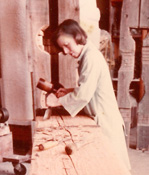 This Goodly Land
This Goodly Land
Annie Vaughan Weaver (May 2, 1905–February 2, 1982)

Other Names Used
- Ann Weaver Norton: married name
Alabama Connections
- Selma, Dallas County: birthplace, childhood residence, place of burial
- Emerald Place, near Sardis, Dallas County: family plantation, wrote her books there
Selected Works
- Weaver, Annie Vaughan. Frawg. New York: F. A. Stokes Co., 1930. For younger readers.
- Weaver, Annie Vaughan. Boochy's Wings. New York: Frederick A. Stokes Co., 1931. For younger readers.
- Weaver, Annie Vaughan. Pappy King. New York: Frederick A. Stokes Co., 1932. For younger readers.
Biographical Information
Annie Vaughan Weaver was born in Selma, Ala., and grew up there and on her family’s plantation, Emerald Place. She wanted to be an artist from a young age and exhibited considerable talent. In 1923, Weaver enrolled at Smith College in Northampton, Mass., majoring in Bible to prepare herself to become a missionary. By the time she had graduated and returned to Selma, however, Weaver had decided that she must go to New York to study art. To raise money for her studies, she wrote and illustrated three books for children, similar to the “Uncle Remus” stories of Joel Chandler Harris. The first one, Frawg, was published in 1930.
In New York, Weaver studied at the Cooper Union Art School, the National Academy of Design, and the Art Students League, and served apprenticeships to established sculptors. She won two Carnegie Foundation Travel Fellowships and studied Romanesque architecture in France and Italy. In 1942, Weaver took a teaching position at the Norton Gallery and School of Art in West Palm Beach, Fla., where she and the Gallery’s founder became close friends. When they married in 1948, Weaver resigned from her teaching position and focused on her sculpture, working in a studio on the Norton estate. In 1977, Weaver turned the estate into a sculpture garden where her work could be displayed in an outdoor setting. When she died of leukemia in 1982, family members brought her ashes back to be interred in Selma.
Interests and Themes
Annie Vaughan Weaver wrote and illustrated children’s books which were based on plantation stories and which made extensive use of black dialect.
For More Information
Please check your local library for these materials. If items are not available locally, your librarian can help you borrow them through the InterLibrary Loan program. Your librarian can also help you find other information about this author.
There may be more information available through the databases in the Alabama Virtual Library. If you are an Alabama citizen, AVL can be used at your public library or school library media center. You can also get a username and password from your librarian to use AVL at home.
Reference Books
- Eiland, William U. Ann Weaver Norton: Sculptor. West Palm Beach, Fla.: Ann Norton Sculpture Gardens, Inc., 2000.
Reference Web Sites
- Ann Norton Sculpture Gardens. 2004. http://www.ansg.org/.
- Hitchcock, Marianne C. "Annie Vaughan Weaver". The Encyclopedia of Alabama. 2009. Alabama Humanities Foundation and Auburn University. http://www.encyclopediaofalabama.org/face/Article.jsp?id=h-2381.
Location of Papers
- Ann Norton Sculpture Gardens, Inc., West Palm Beach, Fla.
Photo courtesy of Ann Norton Sculpture Gardens, Inc.
Last updated on May 30, 2008.